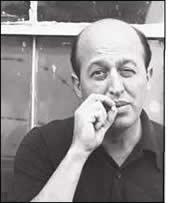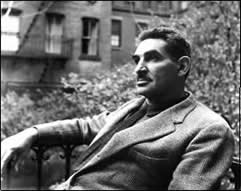
Jacob Collins, founder of the Hudson River School for Landscape, on location in Hunter, New York, August 7, 2008
THE NEW CRITERION
SEPTEMBER 2008
Hudson River Schooled
by James Panero
On Jacob Collins's Hudson River School for Landscape.
Anyone who suspects that nineteenth-century American art has less to teach us than twentieth-century modernism should take a drive up the winding road of Route 23A, up Kaaterskill Clove in the eastern escarpment of the Catskill Mountains. Here in the town of Hunter, New York, a group of young artists is studying the nineteenth-century traditions of the Hudson River School by walking in the footsteps of the original American masters.
In the summer months, Hunter can be a desolate modern town—a weedy ski village in downtrodden Greene County trying to survive the heat while waiting for snow. Ten years ago, an organization called the Catskill Mountain Foundation saw a need to turn this area into more than just a seasonal resort, so the Foundation bought up real estate downtown and set about building an arts program, offering the traditionalist painter and teacher Jacob Collins the use of the Foundation’s buildings for a summer painting school.
This donation became the beginning of Collins’s Hudson River School for Landscape. Dedicated to reviving nineteenth-century landscape technique by “modeling itself after the artistic, social and spiritual values of the Hudson River School painters,” Collins wrote in his mission statement, his school aimed to “bring together the reawakening enthusiasm for the old American painters.” Ideally, he says, his student artists “and their beautiful representations of nature will help to lead the culture back to a stronger connection to the landscape.” This year Collins offered five-week summer fellowships for two dozen painters to live together in Hunter and paint in the surrounding countryside. The school term ran from July 17 through August 22. I dropped in during one mid-session weekend.
Over 180 years before my visit, the painter Thomas Cole went by ship up the Hudson from New York City and disembarked at West Point. He traveled into the Catskill Mountains to paint the terrain around which I was staying, becoming the inspiration for all artists who followed and the ultimate reason for my trip. Cole’s show of Catskill landscapes was a smash when he exhibited in New York in 1826. Widely publicized in the New York Evening Post, Cole’s three paintings included his image of the falls at Kaaterskill, still flowing just down the road from present-day Hunter.
In his History of the American People, Paul Johnson calls Cole, “the first painter to appreciate the immensity of the opportunities offered by the scale and variety of the American landscape.” His Falls at Kaaterskill were likewise “the first American masterpiece of landscape art.” Cole’s achievements sparked an entire movement of landscape painting and opened up the Catskills, in particular the area around Kaaterskill, to a wave of artists. Palenville, at the base of the gorge of Kaaterskill Clove, became America’s first art colony. Lavish hotels went up along the mountaintops around The Clove. A year after Cole’s death, in 1849, Asher B. Durand dedicated perhaps the most famous American landscape painting, Kindred Spirits, to his colleague by depicting Cole and William Cullen Bryant, the poet and editor of the Post, standing on a promontory overlooking Kaaterskill. (In a lowpoint for New York’s artistic patrimony, this painting, in the collection of the New York Public Library for over a century, was sold in 2005 for $35 million to the Wal-Mart heiress Alice Walton of Arkansas.)
At the time of Cole’s initial trip in 1825, the changing wilderness of New York State was very much on the American mind. Emerson’s Transcendentalism was still more than a decade off, but the idea of a natural theology, as articulated by William Paley at the turn of the century, had instilled a new reverence for the natural world. Meanwhile, the Erie Canal, the technological marvel that tamed the West by connecting the Great Lakes with the Hudson River, was built between 1817 and 1825. The rough landscape of rural New York took a literary turn in these years as well. In 1819, Washington Irving located his popular story of Rip Van Winkle in the Catskill Mountains, and four years later James Fenimore Cooper published his colonial story of the Catskill woodsman Natty Bumppo in The Pioneers—one of Cole’s reference books for his trip.
“This is the birthplace, the origin,” Collins said to me when I found him in early August, painting a sky study in an overgrown parking lot off Hunter’s Main Street. Like his students, Collins paints from eight in the morning until sunset, seven days a week when he is in town, building up a portfolio of studies that he will assemble into complete landscapes back in the studio.
After the daytime painting hours are over, the Hudson River School for Landscape turns into a commune and a summer camp. The students in each cabin prepare meals for their housemates. The bonhomie of the school is not lost on Collins, who wants to revive the camaraderie of the Hudson River School. After dinner on the evening I visited, the students laid out the day’s work for a critique that quickly turned technical. “So what would you do, Jacob?” asked Josh, a student, of his latest forest scene. “I would put something in front of it,” said Collins. Then: “When you have a white sky, you can drop the value one step.”
After the crits, Collins introduced George O’Hanlon, the owner of a paint company called Natural Pigments, who came in from California to give a talk. Collins runs a regular evening lecture series for his students, and on the day I visited O’Hanlon delivered a PowerPoint presentation on “The Secrets of the Old Masters.” His talk lasted from nine to eleven-thirty in the evening, but Collins’s students showed little sign of wear as O’Hanlon moved from the chemistry of pigments to the nuances of linseed oil. (His secret of the Old Masters had to do, in part, with the viscous properties of natural pigment versus the homogenized consistency of modern oil paints).
The next morning, a number of the students made the half-mile hike up Kaaterskill Falls. At 260 feet, the two-drop falls of Kaaterskill are the highest in New York. They are also as breathtaking as the day Cole first saw them. Cole’s dark autumn scene of the double cascades, with a mammoth boulder resting in the falls’ upper amphitheater, is both an accurate depiction of the topography and an awesome image of an untamed wilderness—a tiny, lone figure can be seen among the straggly trees and the black rocks.
Have Collins’s students been able to approach the majesty of Cole’s great image? Their successes will depend on the final paintings that, like Cole, they work up in the studio from studies in the field. But I am concerned that these students, with their small, scrupulous studies of rocks and stumps, may be missing the forest for the trees of genuine Hudson River School landscape. In his mission statement, Collins maintains, “It is through extensive and real engagement that the artist learns to capture the spirit of the landscape. The many hundreds of hours spent out in the sun and the wind, scrupulously studying nature, transform the artist. It was by this experience that the old masters of the landscape realized their art. And it is how we hope to realize ours.”
Pragmatism informed by observation is laudable, but during my visit I came to wonder if “extensive and real engagement” was truly enough to “capture the spirit of the landscape.” Collins’s students may be learning the vocabulary of the Hudson River School, but I saw little evidence that they are being taught how to speak it. Collins’s students are young, mainly in their twenties. They are the products of an art world that shouts but has little to say. So the silence offered by Collins’s draftsman drills, developed in his schools in New York and carried over to landscape, is itself a form of rebellion, a release that looks for depth in the details of leaves and bark. But this must only be a means to an end, not an end in itself.
The original Hudson River School was full of secrets—perhaps more than any other movement in American art. So the prospect of a genuine revival giving way to false profundities couched in technique is a serious concern. The original Hudson River School artists did not go into the wilderness to paint illustrations of the natural world. They went to paint the God they saw manifest in the natural world. “It’s the best piece of work that I’ve met with in the woods,” Natty Bumppo says of Kaaterskill Falls in Cooper’s story, “and none know how often the hand of God is seen in the wilderness, but them that rove it for a man’s life.”
Can there be a Hudson River School revival without the revival of God? This is the question that Collins and his students must confront. Their studies, no matter how precise, may never come together as a whole without an underlying philosophy that goes beyond mere proficiency. In a small exhibition I saw of last year’s student work, I found a landscape by Mikel Olazabal, River in Hunter, NY, to be the most accomplished but also the most problematic painting of the show. After viewing it, I walked across the street and down to the riverbank where, along an old foundation, I found the exact spot on which his image was based. Olazabal’s landscape was highly proficient, full of happy thoughts, but it struck me as altogether wrong. With flowers peeking through the rocks and every leaf on every tree glittering in the sun, his buffed-up interpretation was an idealized illustration of rural renewal, mood communicated through mood lighting.
I don’t want to suggest that landscape painters need to seek out ugliness over beauty, but if an artist believes a landscape evinces God, as the original Hudson River School painters surely did, then an artist should not improve on it without cause, or he risks descending into sentimentality.
On the day I visited, the waters of Schoharie Creek had been redirected through plastic pipes around a construction site upstream, so that the dried-out riverbed gave off a sooty odor. I am not sure this unsightly mess would be right on its own for treatment in paint, but when I think back to the best landscape painting of the nineteenth century—and the art of such modern interpreters as Rackstraw Downes—great work is defined by the intersection of industry, agriculture, and wilderness: the tamed farmland in contrast with the rugged forest in The Oxbow by Thomas Cole, or the railroad and tree stumps populating George Inness’s verdant images of the Lackawanna.
For the Hudson River School painter, the entire landscape was part of God’s world. Such thoughts, of course, rarely infiltrate modern belief. “And what remains when disbelief has gone?” asks Philip Larkin in his poem “Church Going”: “Grass, weedy pavement, brambles, buttress, sky,/ A shape less recognizable each week,/ A purpose more obscure.” To understand the Hudson River School today, Collins’s students must learn to see themselves as seminarians as well as painters. They otherwise risk becoming the mere technicians of grass, weedy pavement, brambles, buttress, and sky. Deep in the Catskill wilderness, they may be in a house of God, but that doesn’t mean they’ve got religion.


